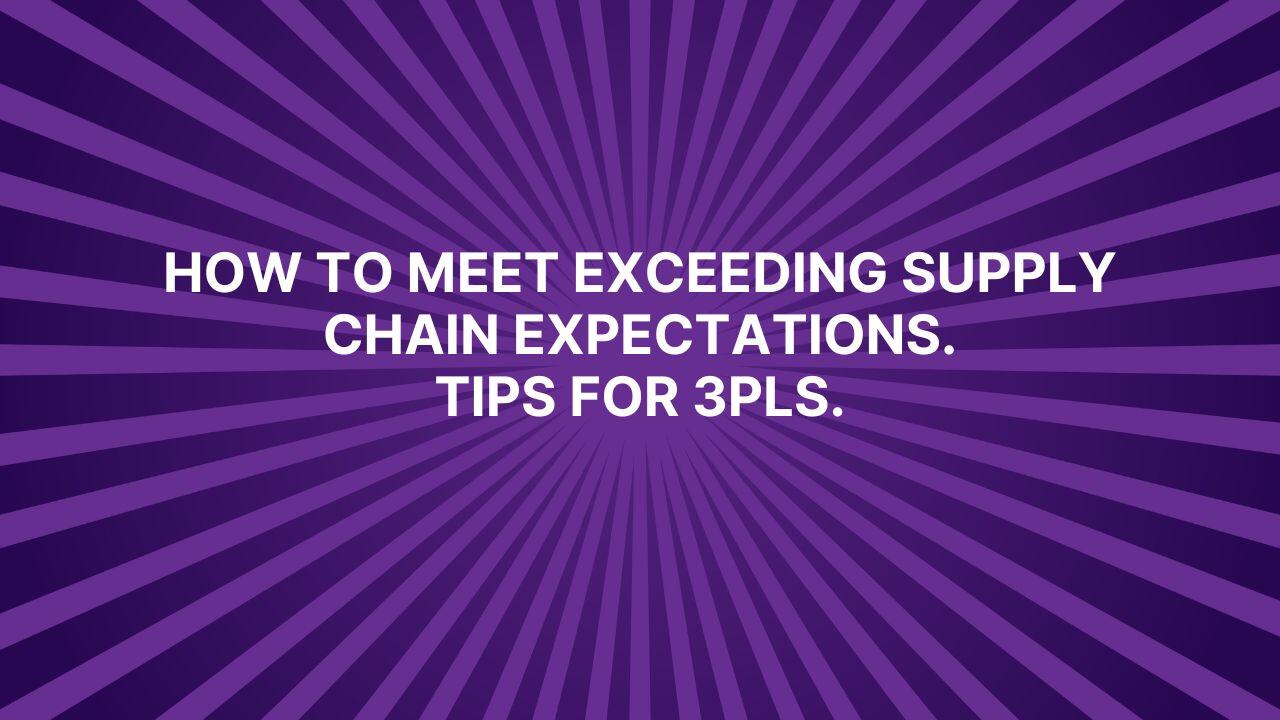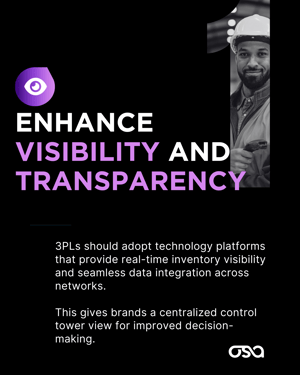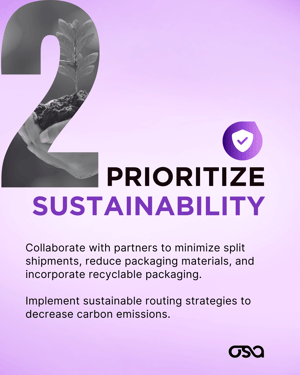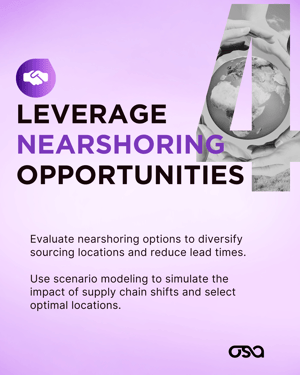4 min read
Navigating the Future: Key Takeaways from the 2025 3PL Study for Logistics Providers and Brands
 Chelsea Mori
:
March 25, 2025
Chelsea Mori
:
March 25, 2025

For third-party logistics (3PL) providers and their brand customers, staying competitive means embracing innovation and making data-driven decisions. The recent 2025 Third-Party Logistics Study, highlights the most pressing challenges and opportunities in the industry, offering valuable insights into the strategies that will define success in the coming years.
At Osa Commerce, we understand the critical role that 3PLs play in supporting brands through these changes. By leveraging integrated logistics technology, real-time visibility, and actionable data, providers can optimize their operations, improve customer satisfaction, and build more resilient supply chains. This recap highlights the study’s key findings, expected trends, and practical steps for 3PLs to exceed expectations and deliver exceptional value to their partners.
Let's dive in.
Key Findings and Trends Shaping 3PLs
The 2025 Third-Party Logistics Study reveals that 3PLs are navigating a landscape marked by heightened customer expectations, the need for greater transparency, and a stronger focus on sustainability. Brands are leaning on their logistics partners to deliver not only faster and more efficient service but also eco-friendly and resilient solutions. Here are the major trends shaping the industry.
Delivery Speed and Visibility as Differentiators
Speed and visibility remain top priorities in the competitive logistics environment. Customers increasingly demand quick, accurate deliveries with full transparency throughout the shipping journey. For 3PLs, providing real-time tracking and reporting is no longer a luxury—it's an expectation. By implementing advanced visibility tools like those offered by Osa Commerce, providers can deliver enhanced customer experiences and gain a competitive edge.
- 53% of shippers and 3PLs identified speed and delivery visibility as the primary competitive advantages.
- Nearly half (48% of shippers, 53% of 3PLs) expect customers to demand deliveries in under two days.
Solutions like Osa’s real-time tracking and reporting can provide the transparency both brands and consumers demand.
Sustainability as a Priority
Sustainability is no longer a secondary consideration—it's a core component of supply chain strategy. Consumers and brands alike are holding companies accountable for their environmental impact. 3PLs that adopt sustainable practices and support their clients’ green initiatives will stand out in the marketplace. Osa Commerce’s integrated solutions can help reduce packaging waste, optimize transportation routes, and lower emissions.
- 47% of shippers emphasize sustainability commitments within their supply chains.
- Integrated systems that reduce packaging, optimize shipping routes, and consolidate orders contribute to environmental goals.
Nearshoring and Supply Chain Resiliency
In the face of global disruptions, supply chain resilience has emerged as a top priority. Many shippers are turning to nearshoring as a way to mitigate risks, reduce lead times, and increase operational stability. 3PLs that support nearshoring efforts with robust data and analytics capabilities will provide significant value. Osa Commerce’s platform offers the insights needed to design and optimize nearshored supply chain networks.
- 76% of shippers and 71% of 3PLs are considering nearshoring to mitigate risks and increase resilience.
By leveraging data-driven insights, Osa Commerce helps businesses optimize network design and ensure supply chain agility.
Data-Driven Decisions
Data is the currency of modern supply chains. With the increasing complexity of logistics operations, brands are relying on AI-powered analytics for better forecasting, decision-making, and optimization. 3PLs that offer advanced analytics capabilities can give brands the actionable insights they need to stay competitive. Platforms like Osa Commerce provide end-to-end visibility, predictive insights, and real-time data to drive smarter supply chain strategies.
- Advanced analytics and AI capabilities are becoming essential, with 33% of shippers demanding AI-powered supply planning and demand forecasting.
- Platforms offering end-to-end visibility and predictive analytics, like Osa Commerce, can offer brands the actionable insights needed to stay competitive.
Meeting Exceeding Supply Chain Expectations: Tips for 3PLs
Enhance Visibility and Transparency
Visibility is the foundation of an agile and resilient supply chain. Without it, brands are left navigating blind, increasing the likelihood of missed deadlines and inefficiencies. Using control tower technology, 3PLs can offer real-time visibility into inventory, shipments, and operations. By adopting solutions like Osa Commerce's integrated platform, providers can deliver actionable insights that empower brands to make data-informed decisions.
- Adopt technology platforms that provide real-time inventory visibility and seamless data integration across networks.
- Offer brands a centralized control tower view for improved decision-making.
Prioritize Sustainability
Sustainability isn’t just a consumer expectation—it’s an operational necessity. Brands are increasingly holding their logistics partners accountable for reducing their carbon footprint. 3PLs can align with these goals by implementing eco-friendly practices like reducing packaging waste, using recyclable materials, and optimizing transportation routes. Collaborative efforts to minimize split shipments and maximize load efficiency are key to making a lasting impact.
- Collaborate with partners to minimize split shipments, reduce packaging materials, and incorporate recyclable packaging.
- Implement sustainable routing strategies to decrease carbon emissions.
Invest in AI and Analytics 
AI and data analytics are redefining how supply chains operate. From predictive demand forecasting to real-time route optimization, AI-powered solutions can drive significant efficiencies. 3PLs that embrace these technologies can provide unparalleled value to their brand customers by enhancing operational agility and proactively addressing disruptions before they escalate.
- Deploy AI-driven tools to forecast demand, optimize routes, and enhance operational efficiency.
- Integrate predictive analytics to proactively identify and mitigate disruptions.
Leverage Nearshoring
Opportunities
Global uncertainties have made supply chain resilience a top priority. Nearshoring offers a practical solution by bringing production and distribution closer to key markets. 3PLs that facilitate nearshoring initiatives can help brands reduce transit times, mitigate risks, and enhance service levels. By using scenario modeling and advanced analytics, providers can identify the most strategic locations to meet evolving consumer demands.
- Evaluate nearshoring options to diversify sourcing locations and reduce lead times.
- Use scenario modeling to simulate the impact of supply chain shifts and select optimal locations.
Optimize for Direct-to-Consumer Growth
The growth of D2C channels is pushing brands to rethink their fulfillment strategies. 3PLs have an opportunity to differentiate themselves by offering tailored D2C solutions, including micro-fulfillment centers, store-based fulfillment, and seamless returns management. Flexible, localized fulfillment options can ensure brands meet consumers’ expectations for fast, convenient delivery.
- Offer flexible fulfillment options, including micro-fulfillment centers and store-based fulfillment.
- Provide streamlined returns management to enhance customer satisfaction.
Final Thoughts
The evolving supply chain landscape requires adaptability and innovation. By focusing on visibility, sustainability, resilience, and data-driven decision-making, 3PLs can meet and exceed brand expectations. Osa Commerce remains committed to empowering logistics providers and their partners with the tools needed to navigate these challenges and seize new opportunities.
For a deeper dive, contact Osa Commerce about how you can stay one step ahead.



